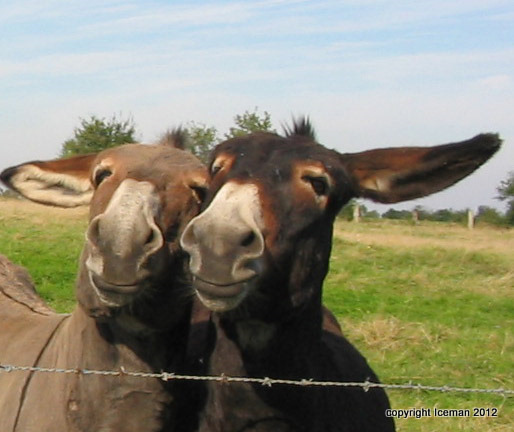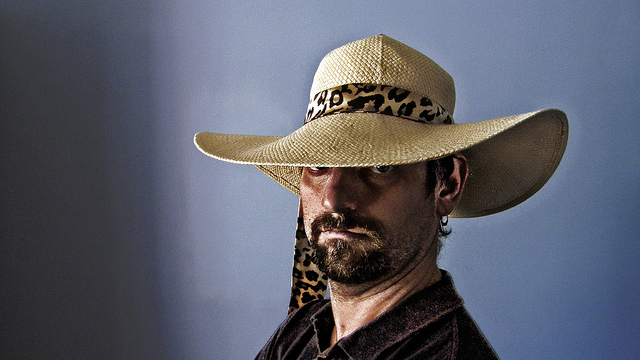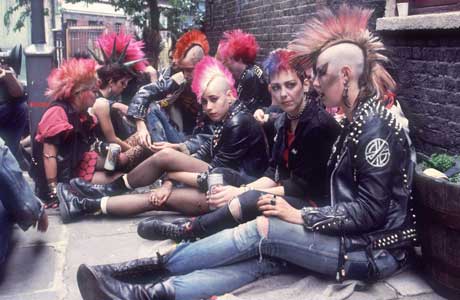Archive for the ‘Level 5 Courage’ Category
The Special People That Believe in You
 Companies don’t need more ideas, they need ideas that are more meaningful. Companies have plenty ideas because they measure and track the number of new ideas generated. Enter your idea on the company’s open innovation web portal, and you’re done. Let the record show that a new idea was added to the hopper. Increment the counter and update the metrics. One new idea for the good guys. It’s a good day to be alive.
Companies don’t need more ideas, they need ideas that are more meaningful. Companies have plenty ideas because they measure and track the number of new ideas generated. Enter your idea on the company’s open innovation web portal, and you’re done. Let the record show that a new idea was added to the hopper. Increment the counter and update the metrics. One new idea for the good guys. It’s a good day to be alive.
For some reason leaders are comforted by a large number of new ideas in the hopper even though there’s no hope of working on them. Maybe they think there’s value in a backlog of ideas they can fall back on if the existing work doesn’t pan out. If that’s the case, they probably think the ideas in the hopper have good potential. But because the ideas are not graded on their potential, that’s simply wishful thinking.
The only thing good about counting the number of new ideas is that the number of new ideas is easy to count. The good thing about grading ideas on their level of meaningfulness is it causes the most meaningful ideas to rise to the top. The bad thing about grading ideas is that it requires judgement. And today, judgment is in short supply. If you use your judgement poorly your career suffers, but if you avoid using your judgement no one notices. Here’s a rule: If you never you use your judgement, you can never use it poorly.
For a select few, any work that doesn’t require judgment doesn’t rise to the level of work worth doing. For them, only the most meaningful work will do, and rolling the dice on their career is simply the cost of doing business. For them, it’s judgement or bust.
If you use your judgement and choose to work on a meaningful idea, be prepared for the loneliness. Meaningful ideas are, by definition, understood by a few and misunderstood by the rest. It’s lonely to advance an idea that most don’t understand. And prepare to be misjudged for your actions because your steadfast pursuit of the idea will also be misunderstood. Your vigor and aliveness will be seen as aggressiveness, anger, negativity, closemindedness, or political incorrectness. But this misjudgment comes with the territory. There’s no way around it. It’s just how it goes. It’s not personal.
But just as the trivial many will try to tear you down, there are a vital few who will praise you, support you and bolster you. These are the special people in your organization. You know who I’m talking about. You have a personal relationship with them. You know about their families. You’ve been through tough times together. They’ve seen you struggle, stumble and tumble, and they’ve seen you get up and move forward. They’ve seen you run into a brick wall and helped you back to your feet. Don’t dismiss their praise and don’t feel guilty about accepting help from them. They don’t want credit for helping you, they want you to succeed.
You don’t know this, but those special people want to help you because you’ve already helped them. Some time ago you unknowingly helped them through a tough time, or were kind to them. Or, you invested in them or believed in them. More than likely, though, you inspired them.
Keep moving forward. Keep pushing. And take comfort from the special people that believe in you.
Image credit – Ice Man
The cards don’t matter. What matters is how you play them.
 What you think of yourself colors everything you do. When someone challenges your ideas, your response makes it clear how you see yourself. Regardless of your response, you tip your hand. Regardless of your response, everyone can see your cards.
What you think of yourself colors everything you do. When someone challenges your ideas, your response makes it clear how you see yourself. Regardless of your response, you tip your hand. Regardless of your response, everyone can see your cards.
When you have a terrible poker hand like, say, a king high, you can respond three ways. You can fold and let the challenger go unchallenged. You can check and kick the can down the road. Or you can bluff and go toe-to-toe with the challenger. With the fold you see things as they are and behave accordingly. The fold is an admission you have a lesser hand. And sometimes that’s difficult to do. The check says you don’t want others to know you have a terrible hand but you thing things will turn around. With the bluff you pretend things are different than they are and you pretend accordingly. You may fool the unseasoned player on your right, but make no mistake, the card shark on your left knows you’re bluffing. And deep down, you know too.
With a middle-of-the-road hand like the full house you have the same options. The fold is less likely because your hand is stronger. You fold only when you sense a strong challenge and the pot is large. No sense going head-to-head with a player with swagger when the stakes are high. There’s no harm in folding. The check says you’re not sure of yourself, or, you are and your hand is neither special nor terrible. The bluff is still risky but less so. If you think you can survive getting caught and are okay with the follow-on judgement, there’s a larger probability you’ll try.
With four aces you call the shots. The fold is reserved for those special situations where you want to preserve the status of players you care about. Or, when you have enough chips and you want others to get the glory. Either way it’s too little used. Few have the self-worth, generosity and thoughtfulness to play things that way. The check is equally generous. The check says you’re comfortable with your cards and how the hand is going. No need to flex your muscles. When you have the winning cards the bluff is counterproductive. Playing bigger than your hand pushes everyone away and they fold. You may with the pot, but next hand they’ll go after you. Embarrassing the other players is no way to play.
Really, though, your cards don’t matter. Regardless of your cards, don’t take a challenge personally. Regardless of your cards, respond like you hold all of them – all the aces, face cards, and all the wild cards.
It relatively easy to behave this way when the professional challenges your ideas because they don’t challenge you, they challenge your ideas. And you are not your ideas. Look deeply and honestly at the ideas and leave your self out of it. But it’s more difficult with the hack. Under the banner of challenging your ideas, the hack will try to challenge you. Here’s where you’ve got to hold onto a fundamental truth – no one can challenge you without your consent. Here’s where you’ve got to remember this truth applies to everyone – those with a four-of-a-kind, those with a full house, and those with a pair of twos. Here’s where you’ve got to remember that your cards don’t matter. The best way I know how to do that is to visualize your self as a screen door and let their hot air pass through you.
The challenges don’t matter and neither does the hand you were dealt. All that matters is your response. Respond with your heart’s best intentions and everyone will split the pot and they’ll want you to deal every hand.
Image credit – lawrence
The Chief Do-the-Right-Thing Officer – a new role to protect your brand.
 Our unhealthy fascination with ever-increasing shareholder value has officially gone too far. In some companies dishonesty is now more culturally acceptable than missing the numbers. (Unless, of course, you get caught. Then, it’s time for apologies.) The sacrosanct mission statement can’t save us. Even the most noble can be stomped dead by the dirty boots of profitability.
Our unhealthy fascination with ever-increasing shareholder value has officially gone too far. In some companies dishonesty is now more culturally acceptable than missing the numbers. (Unless, of course, you get caught. Then, it’s time for apologies.) The sacrosanct mission statement can’t save us. Even the most noble can be stomped dead by the dirty boots of profitability.
Though, legally, companies can self-regulate, practically, they cannot. There’s nothing to balance the one-sided, hedonistic pursuit of profitability. What’s needed is a counterbalancing mechanism of equal and opposite force. What’s needed is a new role that is missing from today’s org chart and does not have a name.
Ombudsman isn’t the right word, but part of it is right – the part that investigates. But the tense is wrong – the ombudsman has after-the-fact responsibility. The ombudsman gets to work after the bad deed is done. And another weakness – ombudsman don’t have equal-and-opposite power of the C-suite profitability monsters. But most important, and what can be built on, is the independent nature of the ombudsman.
Maybe it’s a proactive ombudsman with authority on par with the Board of Directors. And maybe their independence should be similar to a Supreme Court justice. But that’s not enough. This role requires hulk-like strength to smash through the organizational obfuscation fueled by incentive compensation and x-ray vision to see through the magical cloaking power of financial shenanigans. But there’s more. The role requires a deep understanding of complex adaptive systems (people systems), technology, patents and regulatory compliance; the nose of an experienced bloodhound to sniff out the foul; and the jaws of a pit bull that clamp down and don’t let go.
Ombudsman is more wrong than right. I think liability is better. Liability, as a word, has teeth. It sounds like it could jeopardize profitability, which gives it importance. And everyone knows liability is supposed to be avoided, so they’d expect the work to be proactive. And since liability can mean just about anything, it could provide the much needed latitude to follow the scent wherever it takes. Chief Liability Officer (CLO) has a nice ring to it.
[The Chief Do-The-Right-Thing Officer is probably the best name, but its acronym is too long.]
But the Chief Liability Officer (CLO) must be different than the Chief Innovation Officer (CIO), who has all the responsibility to do innovation with none of the authority to get it done. The CLO must have a gavel as loud as the Chief Justice’s, but the CLO does not wear the glasses of a lawyer. The CLO wears the saffron robes of morality and ethics.
Is Chief Liability Officer the right name? I don’t know. Does the CLO report to the CEO or the Board of Directors? Don’t know. How does the CLO become a natural part of how we do business? I don’t know that either.
But what I do know, it’s time to have those discussions.
Image credit – Dietmar Temps
A most powerful practice – Try It.
 The first question is usually – What’s the best practice? And the second question is – Why aren’t you using it? In the done-it-before domain this makes sense. Best practices are best when inputs are tightly controlled, process steps are narrowly defined, and the desired output is known and can be formally defined.
The first question is usually – What’s the best practice? And the second question is – Why aren’t you using it? In the done-it-before domain this makes sense. Best practices are best when inputs are tightly controlled, process steps are narrowly defined, and the desired output is known and can be formally defined.
Industry loves best practice because they are so productive. Like the printing press, best practices are highly effective when it’s time to print the same pages over and over. It worked here, so do it there. And there. And there. Use the same typeface and crank it out – page by page. It’s like printing money.
Best practices are best utilized in the manufacturing domain, until they’re not. Which best practice should be used? Can it be used as-is, or must it change? And, if a best practice is changed, which version is best? Even in the tightly controlled domain of manufacturing, it’s tricky to effectively use best practices. (Maybe what’s needed is a best practice for using best practices.)
Best practices can be good when there’s strong commonality with previous work, but when the work is purposefully different (think creativity and innovation), all bets are off. But that doesn’t stop the powerful pull of productivity from jamming round best practices into square holes. In the domain of different, everything’s different – the line of customer goodness, the underpinning technology and the processes to make it, sell it, and service it. By definition, the shape of a best practice does not fit work that has yet to be done for the first time.
What’s needed is a flexible practice that can handle the variability, volatility, and uncertainty of creativity/innovation. My favorite is called – Try It. It’s a simple process (just one step), but it’s a good one. The hard part is deciding what to try. Here are some ways to decide.
No-to-yes. Define the range of inputs for the existing products and try something outside those limits.
Less-with-far-less. Reduce the performance (yes, less performance) of the very thing that makes your product successful and try adolescent technologies with a radically lower cost structures. When successful, sell to new customers.
Lines of customer goodness. Define the primary line of customer goodness of your most successful product and try things that advance different lines. When you succeed, change all your marketing documents and sales tools, reeducate your sales force, and sell the new value to new customers.
Compete with no one. Define a fundamental constraint that blocks all products in your industry, try new ideas that compromise everything sacred to free up novel design space and break the constraint. Then, sell new products into the new market you just created.
IBE (Innovation Burst Event). Everything starts with a business objective.
There is no best way to implement the Try It process, other than, of course, to try it.
Image credit — Alland Dharmawan.
Skillful and Unskillful
 I used to believe others were responsible for my problem, now I believe I am responsible. The turning point came when I was struggling with a stressful situation a friend gave me some simple advice. He said “Look inside.” For some reason, that was enough for me to start my transformation.
I used to believe others were responsible for my problem, now I believe I am responsible. The turning point came when I was struggling with a stressful situation a friend gave me some simple advice. He said “Look inside.” For some reason, that was enough for me to start my transformation.
I used to compare myself to others. It caused me great pain because I judged myself as inferior. Over time I learned that others compared themselves to me and felt the same way. Also, I learned that success brings problems of its own, namely worry and anxiety around losing what “success” has brought. Though I still sometimes feel inferior, I’ve learned to recognize the symptoms, and once I call them by name, I can move forward.
I used to care too much about money. Though I still care about money, I care more about time.
I used to wrestle with the past and worry about the future. Now I sit in the present, and I like it better. I still slip sometimes, but I catch myself pretty quickly.
I used to be largely unaware of my lack of awareness. Now that I’ve learned to be more aware of it, I’m closer to the people I care about. And I’m aware that I’m just getting started.
I used to want more of everything. Now I have enough and I want to enjoy it.
I used to want to climb the corporate ladder, now I want to do amazing work.
I used to judge my younger self though my older self’s eyes. That was unskillful. I’ve realized that as a younger person my intensions were good, just as they are today. And, I’ve learned that perfection is an unattainable goal and that sometimes I forget.
I used to think that I had to do everything myself. Now I get great joy from helping others do things they thought they couldn’t.
I used to think of myself as a steamroller and I was proud of it. Now I’m a behind-the-scenes conductor who is far more effective and much happier.
I used to be afraid to share my inner thoughts and feelings, but I’m getting better at that.
Image credit – Jai Kapoor
All Your Mental Models are Obsolete
Even after playing lots of tricks to reduce its energy consumption, our brains still consume a large portion of the calories we eat. Like today’s smartphones it’s computing power is too big for it’s battery so its algorithms conserve every chance they get. One of its go-to conservation strategies is to make mental models. The models capture the essence of a system’s behavior without the overhead of retaining all the details of the system.
And as the brain goes about its day it tries to fit what it sees to its portfolio of mental models. Because mental models are so efficient, to save juice the brain is pretty loose with how it decides if a model fits the situation. In fact the brain doesn’t do a best fit, it does a first fit. Once a model is close enough, the model is applied, even if there’s a better one in the archives.
Overall, the brain does a good job. It looks at a system and matches it with a model of a similar system it experienced in the past. But behind it all the brain is making a dangerous assumption. The brain assumes all systems are static. And that makes for mental models that are static. And because all systems change over time (the only thing we can argue about is the rate of change) the brain’s mental models are always out of date.
Over the years your brain as made a mental model of how your business works – customers do this, competitors do that, and markets do the other. But by definition that mental model is outdated. There needs to be a forcing function that causes us to refute our mental models so we can continually refine them. [A good mantra could be – all mental models are out of fashion until proven otherwise.] But worse than not having a mechanism to refute them, we have a formal business process the demands we converge on our tired mental models year-on-year. And the name of that wicked process – strategic planning.
It goes something like this. Take a little time from your regular job (though you still have to do all that regular work) and figure out how you’re going to grow your business by a large (and arbitrary) percentage. The plan must be achievable (no pie in the sky stuff), it should be tightly defined (even though everyone knows things are dynamic and the plan will change throughout the year), you must do everything you did last year and more and you have fewer resources than last year. Any brain in it’s right will fit the old models to the new normal and put the plan together in the (insufficient) time allotted. The planning process reinforces the re-use of old models.
Because the brain believes everything is static, it’s thinking goes like this – a plan based on anything other than the tried-and-true mental models cannot have certainty or predictability in time or resources. And it’s thinking is right, in part. But because all mental models are out of date, even plans based on existing models don’t have certainty and predictability. And that’s where the wheels fall off.
To inject a bit more reality into strategic planning, ignore the tired old information streams that reinforce existing thinking and find new ones that provide information that contradicts existing mental models. Dig deeply into the mismatch between the new information and the old mental models. What is behind the difference? Is the difference limited to a specific region or product line? Is the mismatch new or has it always been there? The intent of this knee-deep dissection is not to invalidate the old models but to test and refine.
There is infinite detail in the world. Take a look at a tree and there’s a trunk and canopy. Look at the canopy and see the leaves. Look deeper to see a leaf and its veins. In order to effectively handle all this detail our brains create patterns and abstractions to reduce the amount of information needed to make it through the day.
In the case of the tree, the word “tree” is used to capture the whole thing – roots and all. And at a higher level, “tree” can represent almost any type of tree at almost any stage in its life. The abstraction is powerful because it reduces the complexity, as long as everyone’s clear which tree is which.
The message is this. Our brain takes shortcuts with its chunking of the world into mental models that go out style. And our brain uses different levels of abstraction for the same word to mean different things. Care must be taken to overtly question our mental models and overtly question the level of abstraction used when statements of facts are made.
Knowing what isn’t said is almost important as what is said. To maintain this level of clarity requires calm, centered awareness which today’s pace makes difficult.
There’s no pure cure for the syndrome. The best we can do is to be well-rested and aware. And to do that requires professional confidence and personal disciple.
Slowing down just a bit can be faster, and testing the assumptions behind our business models can be even faster. Last year’s mental models and business models should be thought of as guilty until proven relevant. And for that you need to make the time to think.
In today’s world we confuse activity with progress. But really, in today’s dynamic world thinking is progress.
Image credit – eyeliam.
Serious Business
 If you’re serious about your work, you’re too serious. We’re all too bound up in this life-or-death, gotta-meet-the-deadline nonsense that does nothing but get in the way.
If you’re serious about your work, you’re too serious. We’re all too bound up in this life-or-death, gotta-meet-the-deadline nonsense that does nothing but get in the way.
If you’re into following recipes, I guess it’s okay to be held accountable to measuring the ingredients accurately and mixing the cake batter with 110% effort. When your business is serious about making more cakes than anyone else on the planet, it’s fine to take that seriously. But if you’re into making recipes, serious doesn’t cut it. Coming up with new recipes demands the freedom of putting together spices that have never been combined. And if you’re too serious, you’ll never try that magical combination that no one else dared.
Serious is far different than fully committed and “all in.” With fully committed, you bring everything you have, but you don’t limit yourself by being too serious. When people are too serious they pucker up and do what they did last time. With “all in” it’s just that – you put all your emotional chips on the line and you tell the dealer to “hit.” If the cards turn in your favor you cash in in a big way. If you bust, you go home, rejuvenate and come back in the morning with that same “all in” vigor you had yesterday and just as many chips. When you’re too serious, you bet one chip at a time. You don’t bet many chips, so you don’t lose many. But you win fewer.
The opposite of serious is not reckless. The opposite of serious is energetic, extravagant, encouraging, flexible, supportive and generous. A culture of accountability is serious. A culture of creativity is not.
I do not advocate behavior that is frivolous. That’s bad business. I do advocate behavior that is daring. That’s good business. Serious connotes measurable and quantifiable, and that’s why big business and best practices like serious. But measurable and quantifiable aren’t things in themselves. If they bring goodness with them, okay. But there’s a strong undercurrent of measurable for measurable’s sake. It’s like we’re not sure what to do, so we measure the heck out of everything. Daring, on the other hand, requires trust is unmeasurable. Never in the history of Six Sigma has there been a project done on daring and never has one of its control strategies relied on trust. That’s because Six Sigma is serious business. Serious connotes stifling, limiting and non-trusting, and that’s just what we don’t need.
Let’s face it, Six Sigma and lean are out of gas. So is tightening-the-screws management. The low hanging fruit has been picked and Human Resources has outed all the mis-fits and malcontents. There’s nothing left to cut and no outliers to eliminate. It’s time to put serious back in its box.
I don’t know what they teach in MBA programs, but I hope it’s trust. And I don’t know if there’s anything we can do with all our all-too-serious managers, but I hope we put them on a program to eliminate their strengths and build on their weaknesses. And I hope we rehire the outliers we fired because they scared all the serious people with their energy, passion and heretical ideas.
When you’re doing the same thing every day, serious has a place. When you’re trying to create the future, it doesn’t. To create the future you’ve got to hire heretics and trust them. Yes, it’s a scary proposition to try to create the future on the backs of rabble-rousers and rebels. But it’s far scarier to try to create it with the leagues of all-too-serious managers that are running your business today.
Image credit — Alan
The Fear of Being Judged
 “Here – I made this.” Those are courageous words. When you make something no one has made and you show people you are saying to yourself – “I know my work will be judged, but that’s the price of putting myself out there. I will show my work anyway.” I think the fear of being judged is enemy number one of creativity, innovation, and living life on your own terms. If I had ten dollars of courage in my pocket I’d spend it to dampen my fear of being judged.
“Here – I made this.” Those are courageous words. When you make something no one has made and you show people you are saying to yourself – “I know my work will be judged, but that’s the price of putting myself out there. I will show my work anyway.” I think the fear of being judged is enemy number one of creativity, innovation, and living life on your own terms. If I had ten dollars of courage in my pocket I’d spend it to dampen my fear of being judged.
No one has ever died from the fear of being judged, but right before you show your new work, share your inner feelings or show your true self, is sure feels like you’re going to be the exception. The fear of being judged is powerful enough to generate self-limiting behavior and sometimes can completely debilitate. It’s vector of unpleasantness is huge.
At a lower level, the fear of being judged is the fear someone will think of you differently than you want them to. It’s a fear they’ll label you with a scarlet letter you don’t want to own. This mismatch is the gradient that drives the fear. If you reduce the gradient you reduce the fear and the self-censorship.
No one can label you without your consent, and if you don’t consent there is no gradient. If you think the scarlet letter does not fit you, it doesn’t. No mismatch. When someone tries to hand you a gift and instead of taking it from them you let it drop to the floor, it’s not your gift. If you don’t accept their gift there is no gradient. But there is a gradient because you think the scarlet letter may actually fit and the gift may actually be yours. You create your fear because you think they may be right.
In the end it’s all about what you think about yourself. If your behavior is skillful and you know it, you will not accept someone else’s judgment and there’s no fear-fueling gradient . If your approach is purposefully thoughtful, you will not consent to labeling. If you know your intentions are true, there can be no external mismatch because there is no internal mismatch.
No one can be 100% skillful, purposeful, thoughtful and intentional. But directionally, behaving this way will reduce the gradient and the fear. But the fear will never go away, and that’s why we need courage. Be skillful and afraid and do it anyway. Be thoughtful and scared and do what scares you. Be true to your heart’s intention and just courageous as you need to be to wrestle your fears to the ground.
Image credit – Paul Townsend
It’s time to make a difference.
 If on the first day on your new job your stomach is all twisted up with anxiety and you’re second guessing yourself because you think you took a job that is too big for you, congratulations. You got it right. The right job is supposed to feel that way. If on your first day you’re totally comfortable because you’ve done it all before and you know how it will go, you took the job for the money. And that’s a terrible reason to take a job.
If on the first day on your new job your stomach is all twisted up with anxiety and you’re second guessing yourself because you think you took a job that is too big for you, congratulations. You got it right. The right job is supposed to feel that way. If on your first day you’re totally comfortable because you’ve done it all before and you know how it will go, you took the job for the money. And that’s a terrible reason to take a job.
You got the job because someone who knew what it would take to get it done believed you were the right one to do just that. This wasn’t charity. There was something in it for them. They needed the job done and they wanted a pro. And they chose you. The fact their stomach isn’t in knots says nothing about their stomach and everything about their belief in you. And the knots in your stomach? That ‘s likely a combination of immense desire to do a good job and an on-the-low-side belief in yourself.
If we’re not stretching we’re not learning, and if we’re not learning we’re not living. So why the nerves? Why the self doubt? Why don’t we believe in ourselves? When we look inside, we see ourselves in the moment – in the now, as we are. And sometimes when we look inside there are only re-run stories of our younger selves. It’s difficult to see our future selves, to see our own growth trajectory from the inside. It’s far easier to see a growth trajectory from the outside. And that’s what the hiring team sees – our future selves – and that’s why they hire.
This growth-stretch, anxiety-doubt seesaw is not unique to new jobs. It’s applicable right down the line – from temporary assignments, big projects and big tasks down to small tasks with tight deliverables. If you haven’t done it before, it’s natural to question your capability. But if you trust the person offering the job, it should be natural to trust their belief in you.
When you sit in your new chair for the first time and you feel queasy, that’s not a sign of incompetence it’s a sign of significance. And it’s a sign you have an opportunity to make a difference. Believe in the person that hired you, but more importantly, believe in yourself. And go make a difference.
Image credit – Thomas Angermann
Are you striving or thriving?
 Thriving is not striving. And they’re more than unrealated. They’re opposites.
Thriving is not striving. And they’re more than unrealated. They’re opposites.
Striving is about the now and what’s in it for me. Thriving is about the greater good and choosing – choosing to choose your own path and choosing to travel it in your own way. Thriving doesn’t thrive because outcomes fit with expectations. Thriving thrives on the journey.
Where striving comes at others’ expense, thriving comes at no one’s expense. Where striving strives on getting ahead, thriving thrives on growing. Striving looks outwardly, thriving looks inwardly. No two words are spelled so similarly yet contradict so vehemently.
Plants thrive when they’re put in the right growing conditions. They grow the way they were meant to grow and they don’t look back. They thrive because they don’t second guess themselves. If they don’t grow as tall as others, they’re happy for the tallest. And if they bloom bigger and brighter than the rest, they’re thoughtful enough to make conversation about other things.
Plants and animals don’t strive. Only people do. Strivers live their lives looking through the lens of the zero sum game. Strivers feel there’s not enough sunlight to go around so they reach and stretch and step on your head so they get a tan and leave you to supplement with vitamin D.
I can deal with strivers that tell you they’re going to step on your head and step on it just as they said. And I have immense disdain for strivers that pretend they’re sunflowers. But when I’m around thrivers I resonate.
Strivers suck energy from the room and thrivers give it way freely. And just as the bumblebee gets joy from spreading the love flower-to-flower, thrivers thrive more as they give more.
If you leave a meeting feeling good about yourself and three days later you rethink things and feel like a lesser person, you were victimized by a striver. If you feel great about yourself after a meeting and three days later feel even better, you rubbed shoulders with a thriver.
Learn to spot the strivers so you can distance yourself. And seek out the thrivers so you can grow with them.
Image credit Brad Smith
The People Business
Things don’t happen on their own, people make them happen.
With all the new communication technologies and collaboration platforms it’s easy to forget that what really matters is people. If people don’t trust each other, even the best collaboration platforms will fall flat, and if they don’t respect each other, they won’t communicate – even with the best technology.
Companies put stock in best practices like they’re the most important things, but they’re not. Because of this unnatural love affair, we’re blinded to the fact people are what make best practices best. People create them, people run them, and people improve them. Without people there can be no best practices, but on the flip-side, people can get along just fine without best practices. (That says something, doesn’t it?) Best practices are fine when processes are transactional, but few processes are 100% transactional to the core, and the most important processes are judgement-based. In a foot race between best practices and good judgement, I’ll take people and their judgment – every day.
Without a forcing function, there can be no progress, and people are the forcing function. To be clear, people aren’t the object of the forcing function, they are the forcing function. When people decide to commit to a cause, the cause becomes a reality. The new reality is a result – a result of people choosing for themselves to invest their emotional energy. People cannot be forced to apply their life force, they must choose for themselves. Even with today’s “accountable to outcomes” culture, the power of personal choice is still carries the day, though sometimes it’s forced underground. When pushed too hard, under the cover of best practice, people choose to work the rule until the clouds of accountability blow over.
When there’s something new to do, processes don’t do it – people do. When it’s time for some magical innovation, best practices don’t save the day – people do. Set the conditions for people to step up and they will; set the conditions for them to make a difference and they will. Use best practices if you must, but hold onto the fact that whatever business you’re in, you’re in the people business.
Image credit – Vicki & Chuck Rogers


 Mike Shipulski
Mike Shipulski